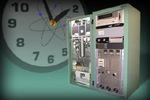Sir SandFord Fleming - The Knight Of Time
The scientific second

At the turn of the twentieth century, the federal Observatory responsible for coordinating official time in Canada was able to produce highly precise time measurements, accurate within 0.05s, by using pendulum clocks and observation of star positions with a meridian telescope.
In 1941, the Obervatory used an even more precise quartz clock. In the middle of the twentieth century, scientists questioned the instruments they used to measure time as the requirements for accurate calculations became ever more pressing. Rather than relying on the earth’s rotation, it was proposed that calculations be based on observation of the orbital motions of planets and their satellites, using 1900 as the year of reference.
In the late 1950s atomic clocks, scattered throughout the world and coordinated by radio, began to measure time and to mark Universal Time Coordinated (UTC). These clocks use cesium beams and are still the best instruments for measuring time.
All of the world’s time zones now rely on UTC.